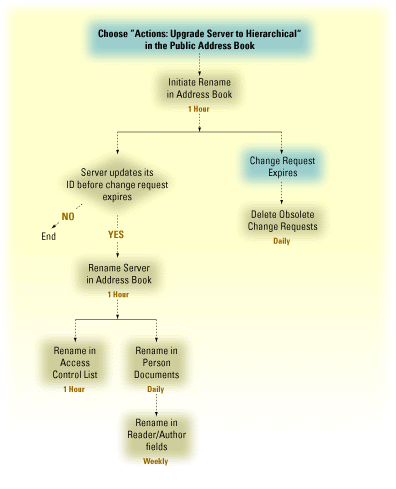 | Roadmap of Administration Process Requests: Converting a server to hierarchical naming
[return to the Roadmap Administration Process Requests main article]

 

Level:
Works with:
Updated:

Inside this article:

Related links:

Get the PDF:

|  | You can use the Administration Process to convert a flat server to hierarchical naming. This is the only kind of server renaming you can use the Administration Process for. The following sequence of requests occurs:

Details on converting a server to hierarchical naming
Here are details on the "how, why, where, and when" of each request involved with converting a server to hierarchical naming.
Initiate Rename in Address Book
Triggered by: Selecting a Server document in the Public Address Book and choosing "Actions - Upgrade Server to Hierarchical."
Posted on: The server where you choose the upgrade action.
Carried out on: The administration server for the Public Address Book.
Carried out: According to the Interval setting for the Administration Process in the Server document.
Result: The Administration Process adds the hierarchical certificate to the "Certified public key" field in the Server document and a change request to the "Change request" field.
Rename Server in Address Book
Triggered by: The server updating its ID with the new hierarchical name and certificate when the server detects the name change in the "Change request " field of its Server document.
Posted on: The server whose name has changed.
Carried out on: The administration server for the Public Address Book.
Carried out: According to the Interval setting for the Administration Process in the Server document.
Result: Updates all remaining occurrences of the server name in the Public Address Book except in Person documents.
Rename in Person Documents
Triggered by: Completion of the "Rename Server in Address Book" request.
Posted on: The administration server for the Public Address Book.
Carried out on: The administration server for the Public Address Book.
Carried out: According to the "Execute once a day requests at" setting for the Administration Process in the Server document.
Result: The Administration Process updates occurrences of the name in Public Address Book Person documents.
Rename in Access Control List
Triggered by: Completion of the "Rename Server in Address Book" request.
Posted on: The administration server for the Public Address Book
Carried out on: Each server in the domain.
Carried out: According to the Interval setting for the Administration Process in the Server document.
Result: Each server in the domain updates the server name in ACLs of databases for which it is an administration server.
Rename in Reader/Author Fields
Triggered by: Completion of the "Rename in Person Documents " request on the administration server for the Public Address Book.
Posted on: The administration server for the Public Address Book.
Carried out on: Each server in the domain.
Carried out: According to the "Delayed Request" settings for the Administration Process in the Server document.
Result: Each server in the domain updates the name in Reader and Author fields of databases for which it is an administration server and that have the advanced ACL option "Modify all Reader and Author fields" selected.
Delete Obsolete Change Requests
Triggered by: Expiration of the period in which a server can accept a new name, by default 21 days. You can use the NOTES.INI setting Name_Change_Expiration_Days to change the expiration period.
Posted on: The administration server for the Public Address Book.
Carried out on: The administration server for the Public Address Book.
Carried out: According to the "Execute once a day requests at" setting for the Administration Process in the Server document.
Result: The Administration Process deletes the contents of the Change Request field from the Server document.
[go to the Deleting a person's name task]
[return to the Roadmap Administration Process Requests main article]
Copyright 1997 Iris Associates, Inc. All rights reserved. |